Fas -670 A/G polymorphism predicts prognosis of hepatocellular carcinoma after curative resection in Chinese Han population
Xin-Yi Guo , Yi-Lin Xi , Zhi-Yng Li , Rn Li , Yng Fn , Wen-Mo Yo , Fei Liu ,*
a West China School of Medicine, West China Hospital, Sichuan University, Chengdu 610041, China
b Department of Liver Surgery & Liver Transplantation Center, West China Hospital, Sichuan University, Chengdu 610041, China
Keywords:Hepatocellular carcinoma Single nucleotide polymorphism Cell apoptosis Prognosis Resection
ABSTRACT
Background: Apoptosis, also called programmed cell death, is a genetically controlled process against hyperproliferation and malignancy. The Fas-Fas ligand (FasL) system is considered a major pathway for apoptosis in cells and tissues. Thus, this study aimed to investigate whether single nucleotide polymorphisms (SNPs) in Fas and FasL gene may have effects on the recurrence and survival of patients with hepatocellular carcinoma (HCC) after curative hepatectomy.
Methods: We investigated the relationship between Fas rs1800682, rs2234767 and FasL rs763110 polymorphisms and recurrence-free survival (RFS) as well as overall survival (OS) in 117 Chinese Han patients with HCC who underwent hepatectomy.
Results: In Kaplan-Meier survival analysis, only Fas rs1800682 (-670 A/G) was associated with RFS and OS. Compared with AA genotype, the AG/GG genotype was significantly associated with better RFS ( P = 0.008) and OS ( P = 0.020). Moreover, multivariate Cox regression analysis showed that Fas rs1800682 remained as a significant independent predictor of RFS for HCC patients with hepatectomy[AG/GG vs. AA: adjusted hazard ratio = 0.464, 95% confidence interval: 0.275-0.782, P = 0.004], but was not an independent predictor of OS ( P = 0.395).
Conclusions: This study demonstrated that Fas -670 G allele may play a protective role in the recurrence and survival of HCC patients with hepatectomy. Furthermore, Fas rs1800682 polymorphism might be a promising biomarker for HCC patients after hepatectomy.
Introduction
Liver cancer is one of the most common malignant tumors worldwide. In China, liver cancer ranks the third in both most commonly diagnosed cancer and cancer mortality [1] . Of all the liver cancer cases, hepatocellular carcinoma (HCC) approximately comprises 75% [2] . Among the various therapeutic options of HCC,liver resection is one of the first-line treatments for HCC at early stage [3] . However, the prognosis after hepatectomy still remains unsatisfactory. The rate of cancer recurrence within five years after surgery keeps high to 60%-70% [4] . Postsurgical recurrence of HCC includes common intrahepatic recurrence (accounting for most of recurrences) and extrahepatic recurrence [5] . In recent years, various potential prognostic predictors of recurrences have been reported, including microvascular invasion (MVI) [ 2 , 4 , 6-8 ], tumor size [ 4 , 6-9 ], the number of tumors [ 2 , 4 , 7 , 8 ], and alpha-fetoprotein(AFP) [ 7 , 8 ]. However, none of them can meet the requirement of clinical accuracy. For example, several studies found that patients with tumors larger than 5 cm have a significantly higher risk of recurrence [ 4 , 6-9 ], while a few studies failed to find a significant effect between tumor size and recurrence rate, which means that patients with smaller tumor may also have high risk of recurrence [ 10, 11]. It was suggested that individual genetic factors may impact HCC recurrence. According to the development of individualized comprehensive therapy, accumulated evidences have indicated that single nucleotide polymorphisms (SNPs) were associated with prognoses of HCC [12] , non-small cell lung cancer(NSCLC) [ 13 , 14 ], and squamous cell carcinoma of the oropharynx(SCCOP) [15] .
Apoptosis, also called programmed cell death, is a genetically controlled process against hyperproliferation and malignancy [16] .The Fas-Fas ligand (FasL) system is a major pathway for apoptosis in cells and tissues [17] . The Fas is mapped on the human chromosome 10q24.1 and widely expressed in normal and neoplastic cells, including normal hepatocytes and HCC cells [ 17 , 18 ].The FasL is mapped on the human chromosome 1q23 and expressed in activated T cells or natural killer (NK) cells [ 18 , 19 ].Combination of Fas and FasL transmits the signal for cell death to target cell and then triggers extrinsic and intrinsic pathways in human [ 16 , 20 ]. There is accumulating evidence that expression of Fas, FasL and related molecules plays an essential role in pathogenesis of many kinds of tumors including HCC [ 17 , 21 ]. Studies showed that down-regulation of theFasgene may help tumor cells escape from immune surveillance, and up-regulation of theFasLgene may increase the ability of tumor cells through inducing apoptosis of lymphocytes [ 22 , 23 ].
Several potential functional SNPs ofFasandFasLgene were found to be associated with susceptibility, progression and prognosis of cancers. The Fas -670 A>G (rs1800682) have been proved to be related to higher risk of many kinds of cancers, including breast cancer, esophageal cancer, prostate cancer, HCC [24] , and prognoses of NSCLC [ 13 , 14 ], SCCOP [15] , and chronic myeloid leukemia [25] .One of these studies showed that the GG genotype and combined AG/GG genotypes are associated with a poor prognosis in NSCLC [14] . The FasL-844 C>T (rs763110) also was found to be associated with prognoses of chronic myeloid leukemia [25] , breast cancer [26] , and bladder cancer [27] . The CC genotype and C allele were suggested to be both possibly related to a better prognosis of breast cancer [26] . In addition, the Fas -1377 G>A (rs2234767)is related to prognosis of breast cancer [28] . Sunter et al. reported that patients with A allele have worse prognosis compared with GG genotype in acute promyelocytic leukemia [29] .
The present study aimed to analyze the relationship between three key SNPs and the survival of patients with HCC and HCC recurrence after resection.
Methods
Study populations
A total of 117 Chinese Han patients newly diagnosed with HCC from January 2011 to November 2014 were enrolled in this study.The diagnoses were established by postoperative histopathologic examination. All the patients who underwent liver resection in the Department of Liver Surgery, West China Hospital of Sichuan University (Chengdu, China), without any treatments before the resection, were included. The exclusion criteria were: 1) pregnancy; 2)having mental disorder; and 3) having cancer from other organs.
Written informed consents were obtained from all patients.Clinical information included preoperative results of clinical laboratory tests, such as AFP level, tumor size, the number of tumor(s),existence of portal vein tumor thrombus and the other vascular invasion, distant metastasis, lymph node metastasis, liver cirrhosis,differentiation degree of cancer cell, and preoperative Child-Pugh grade. Identification of the clinical stage of tumor is based on the unified 8th edition TNM (tumor-node-metastasis) criteria [30] .
We followed up the 117 patients to November 2019. The recurrence-free survival (RFS) time was calculated from the date of performing tumor resection to the date of diagnosing recurrence or the last follow-up. Tumor recurrence was considered as appearance of new intra- or extra-hepatic tumor nodule(s), with or without an increase in serum AFP level [5] . The overall survival (OS)time was defined from the date of the operation to the date of allcause death or the last follow-up. This study was coincident withtheDeclarationofHelsinki, and approved by the Ethics Committee of Sichuan University.

Table 1 SNPs of cell death pathway genes evaluated in this study.
Selection of candidate SNP
The SNPs were selected based on previous articles reporting the association with development and prognosis of all kinds of cancers, especially HCC. At the same time, we focused on a series of comprehensive SNP-selecting principles to ensure that our research went on wheels as far as possible. The candidate SNPs were the SNPs genotyped in the Chinese Han populations (Han Chinese in Beijing and Southern Han Chinese), chosen from the 10 0 0 Genomes Project database using the Phase 3 data. Selection of tagging SNPs should satisfy the following requirements: the minor allele frequency (MAF) of selected SNPs ≥0.1 in Chinese Han people and only choosing one when several SNPs have a linkage coefficientr² >0.8. Eventually, three tagging SNPs [31-33] in two candidate genes were chosen for this study ( Table 1 ), including two SNPs (rs1800682, rs2234767) from Fas and only one SNP (rs763110)from FasL.
Genotype analysis
Genomic DNA was extracted from whole blood samples of patients with the whole blood DNA kit (Biotake corporation, Beijing,China). According to the manufacturer’s protocol, DNA was isolated from 200 μL of the whole blood. And then, the concentration of isolated DNA was diluted to 20 ng/ μL for working solution, which was stored at -20 °C until analysis. SNP genotyping was conducted on MassARRAY system (Sequenom, San Diego, CA, USA) with matrix assisted laser desorption ionisation-time of flight mass spectrometry method (MALDI-TOF), according to the manufacturer’s protocol. Primers for polymerase chain reaction (PCR) and single base extension were both designed by Assay Design software package (Sequenom). More detailed process could be found in our previous study [34] and the supplementary materials (Table S1). For quality control, 5% of 117 samples were randomly chosen to analyze twice for each locus. Moreover, in order to further validate the genotyping result of MALDI-TOF, about 5% of samples were further verified by direct sequencing method.
Statistical analysis
The characteristics of patient data were expressed as numbers (percentages). The relations of the three tagging SNPs to RFS and OS were identified utilizing the Kaplan-Meier survival analysis with the log-rank test. The relations of the other variables to RFS and OS were estimated using the Cox univariate regression analysis. Those significant variables in univariate analysis were included in a Cox multivariate model, using the forward stepwise (likelihood ratio), to complete multivariate analysis. All statistical analyses were conducted utilizing SPSS version 23.0 statistical software(SPSS Inc., Chicago, IL, USA). AP<0.05 was considered statistically significant.
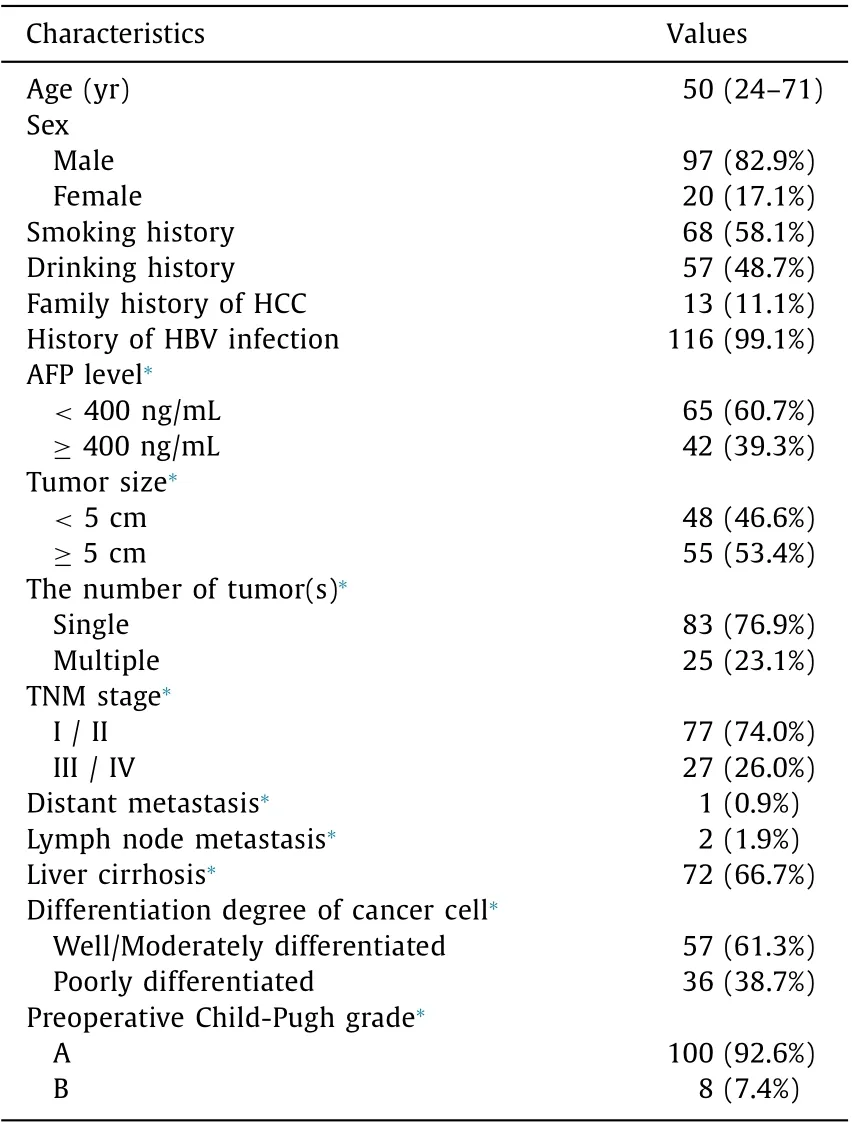
Table 2 Baseline characteristics and clinical characteristics of the patients.
Results
Characteristics of populations and genotype frequency
The baseline characteristics of the 117 HCC patients are summarized in Table 2 . Their age ranged from 24 to 71 years with a median age of 50 and 82.9% were male. Among the 117 patients, 68 (58.1%) had smoking history (all of them smoke more than 400 cigarettes one year), and 13 (11.1%) had family history of HCC, while nearly all the patients (99.1%) had an HBV infection history. Besides, only two patients had regional lymph node metastasis; one had distant metastasis at first diagnosis. One hundred(92.6%) patients had Child-Pugh grade A.
Among the investigated SNPs, as shown in Table 3 , the AA, AG and GG genotypes in Fas -670 A/G (rs1800682) corresponded to 26.5%, 56.4% and 17.1% of patients, respectively; the frequencies of major allele (A) and minor allele (G) were 0.55 and 0.45, respectively. For Fas -1377 G/A (rs2234767), patients with genotypes AA,AG and GG account for 14.5%, 53.8% and 31.6%; the frequencies of major (G) and minor (A) allele were 0.59 and 0.41, respectively. The proportion of patients with CC, CT and TT genotypes in FasL -844 T/C (rs763110) were 50.4%, 40.2% and 9.4%; and the frequencies of major (C) and minor (T) allele were 0.71 and 0.29.
Univariate analysis of genotype and clinicopathological variables
The 1-, 3-, and 5-year RFS rates were 56.1%, 40.9%, 33.9%, respectively. The association between three genotypes (AA, AG, GG)and RFS were analyzed firstly. As shown in Fig. 1 A, the AG and GG genotypes in rs1800682 were both associated with better 5-year RFS after liver resection, compared with the AA genotype(P= 0.027). For the further exploration of the advantages of G allele, the analysis between AA homozygotes and the other two genotypes, as well as between GG homozygotes and the other two genotypes in rs1800682 were conducted. The RFS rate in the AG/GG genotypes was significantly better versus AA homozygotes(P= 0.008, Fig. 1 B). Conversely, there was no significant difference of RFS between the GG homozygotes and AA/AG genotypes(P= 0.837, Fig. 1 C). And Fig. 2 A, B show the RFS of the other two SNPs by every genotype.
The 1-, 3-, and 5-year OS rates were 86.6%, 74.6%, and 70.1%, respectively. The association between three genotypes (AA, AG, GG)and OS were also analyzed. As shown in Fig. 3 A, no significant association among the OS of AA, AG and GG genotypes in rs1800682 were observed (P= 0.062), though an important phenomenon that AG and GG genotypes tend to manifest better 5-year OS compared with AA genotype was noticed. As the exploration in RFS,the analysis between AA homozygotes and the other two genotypes, as well as between GG homozygotes and the other two genotypes in rs1800682 were conducted, respectively. The OS rate in the AG/GG genotypes was significantly better than AA homozygotes (P= 0.020, Fig. 3 B). Conversely, there was no significant difference of OS between the GG homozygotes and AA/AG genotypes(P= 0.365, Fig. 3 C). And Fig. 2 C, D show the OS of the other two SNPs by every genotype.
In addition, we detected the association between other clinicopathological factors and HCC prognosis after resection. By the Cox univariate regression analysis, a younger age, multiple tumors, tumor size larger than 5 cm, advanced tumor staging (TNM III/IV stages), and the presence of background cirrhosis were significantly associated with shorter RFS ( Table 4 ), and multiple tumors,advanced tumor staging (TNM III/IV stages), and the presence of background cirrhosis were significantly associated with worse OS( Table 5 ).
Cox regression model in multivariate analysis
As shown in Tables 4 and 5 , Fas -670 A/G (rs1800682) remained as a significant independent predictor of RFS for HCC patients with hepatectomy (AG/GG vs. AA: adjusted hazard ratio = 0.464, 95%confidence interval: 0.275-0.782,P= 0.004), but was not an independent predictor of OS (P= 0.395).
Discussion
To the best of our knowledge, this is the first study to investigate whether Fas -670 A/G polymorphism may have effects on the recurrence and survival of HCC patients undergoing curative resection. In this study, we investigated the relationship between three SNPs fromFasandFasLgene and clinical outcomes of HCC patients undergoing hepatic resection. The results suggested that AG and GG genotypes in rs1800682 were significantly associated with a better 5-year RFS and OS compared with AA genotype. Furthermore, the SNP, rs1800682 ofFasgene, could serve as an independent predictive factor of postoperative recurrence for resected HCC.
There has been no recognized comprehensive prognostic evaluation system up to now, but in the past decades, numerous potentially prognostic predictors have been reported, not only including several common variables, like sex [ 4 , 8 ], age [ 2 , 35 ], tumor size [ 4 , 6-9 ], the number of tumors [ 2 , 4 , 7 , 8 ], presence of liver cirrhosis [ 4 , 36 ], presence of MVI [ 2 , 4 , 6-8 ], TNM stage [7] , BCLC stage [7] , Edmond-Steiner grade [2] , and Child-Pugh class [7] , but also including some newly discovered indices, such as neutrophilto-lymphocyte ratio [6] , Glasgow prognostic score [6] , serum level of protein induced by vitamin K absence or antagonist (PIVKA) [6]and AFP [ 7 , 8 ], albumin-bilirubin (ALBI) grade [8] , tumor expression of epithelial cell adhesion molecule (EpCAM) [9] , plateletcount [2] , and intraoperative estimated blood loss (EBL) [2] . However, as far as we know, no one has been universally recognized.Despite the existence of various staging systems for HCC, none of them could maintain enough accuracy for prognostic prediction. Although TNM stage, developed by the American Joint Committee on Cancer (AJCC) and Union for International Cancer Control (UICC), is used worldwide [37] and considered as a comparatively effective prognostic indicator in many kinds of malignant tumors, such as lung cancer [13] , it is not very satisfying in HCC.There was a study reporting that TNM stage was not an independent predictor of HCC recurrence [9] . Besides, BCLC stage was not always effective. Another study published in 2014 also indicated that both TNM and BCLC stage were not always associated with recurrence and survival when choosing different follow-up time [38] .
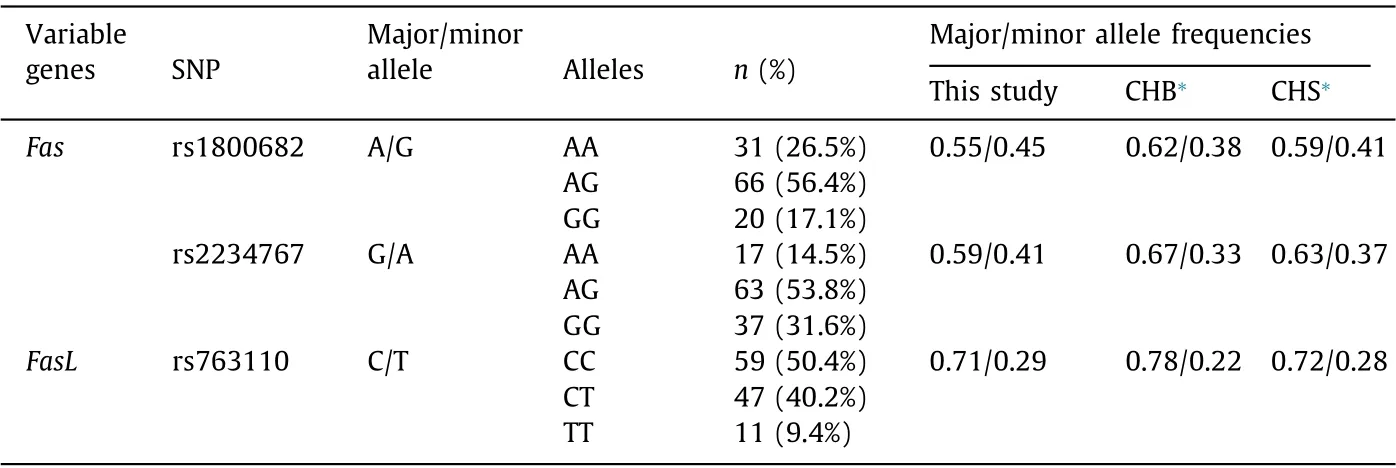
Table 3 Allele frequency of Fas and FasL polymorphisms.
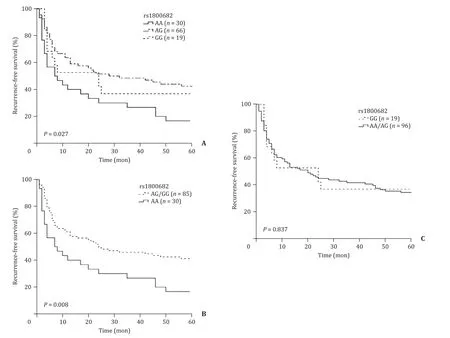
Fig. 1. Kaplan-Meier curves of recurrence-free survival of patients with tumor resection by Fas -670 A/G (rs1800682).
According to the development of individualized comprehensive therapy, genotype analysis plays an increasingly important role in prediction of clinical outcomes and guidance of clinical treatment. Therefore, discovering new genetic biomarkers could facilitate personalized treatment or be incorporated into certain staging systems to improve predictive accuracy of resected HCC, thereby improving the prognoses of patients. Until now, SNPs of gene in cell death pathway have achieved a lot of progress. In two metaanalysis published in 2014, Fas -670 A/G polymorphism was reported to be associated with susceptibility of HCC and many kinds of cancers [ 24 , 39 ]. In addition, a recent study from our team has shown that CASP8 -652 6N ins/del polymorphism in cell death pathway may play an important role in the development, progression, and survival of HBV-related HCC [16] . Nonetheless, related research on the relationship between Fas -670 A/G polymorphism and prognosis of resected HCC is still absent.
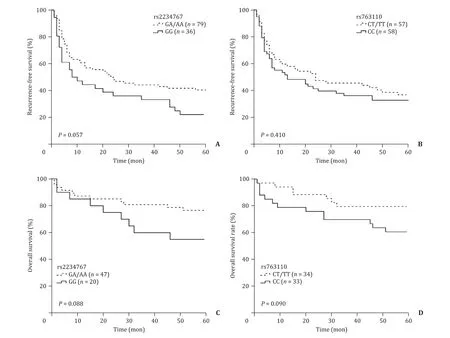
Fig. 2. Recurrence-free survival and overall survival by genotype of rs2234767 and rs763110 in patients ( A-D ).
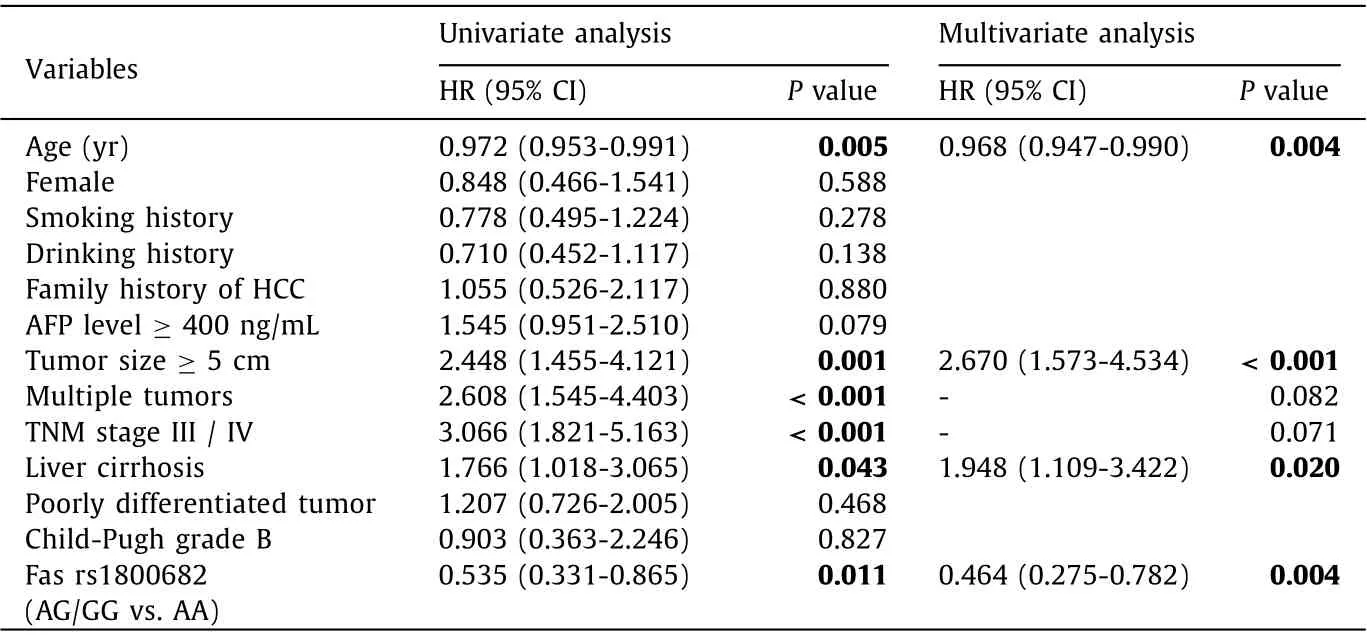
Table 4 Univariate and multivariate analyses of genotypes and clinicopathological parameters associated with recurrence-free survival.
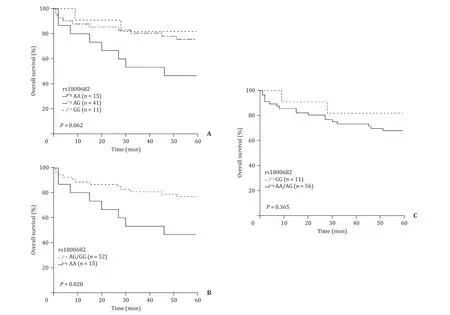
Fig. 3. Kaplan-Meier curves of overall survival of patients with tumor resection by Fas -670 A/G (rs1800682).
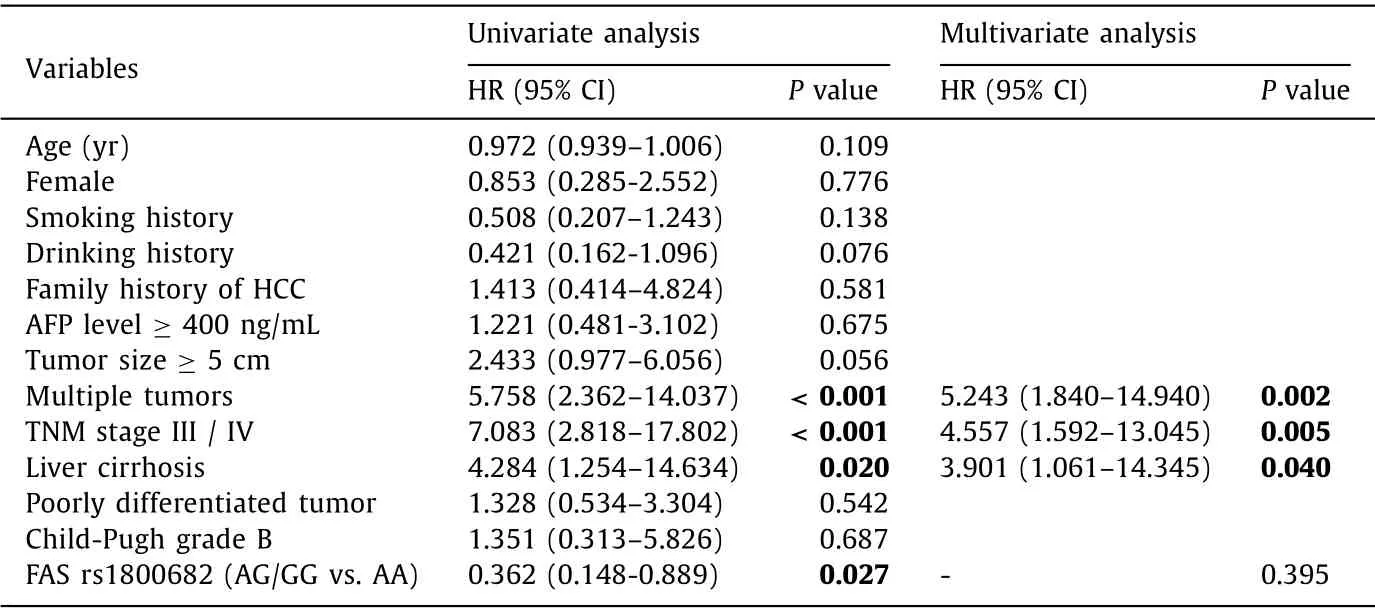
Table 5 Univariate and multivariate analyses of genotypes and clinicopathological parameters associated with overall survival .
Fas, encoded byFasgene, is widely expressed on normal and neoplastic cells (including normal hepatocytes, HCC cells, immune cells and so on), and initiates death receptor pathway by the combination with FasL [17] . Our results illustrate that Fas rs1800682 A>G polymorphism was associated with better survival in patients with resected HCC. This SNP was an independent predictor of 5-year RFS for resected HCC patients. According to previous research data, rs1800682 was located in the enhancer region ofFasgene, which was combined with STAT1 to modulate the transcription activity ofFasgene; theA-to-Gsubstitution polymorphism can diminish promoter activity and downregulate gene expression [24] .The explanation of our result has three aspects. Firstly, activated T-lymphocytes, having a crucial role in immune surveillance, can be induced into apoptosis by activation induced cell death (AICD),mediated mainly by the death-receptor pathway, which could be beneficial to tumor cells escaping from immune surveillance [40] .Hence, in stimulated T-lymphocyte, this A>G polymorphism downregulatedFasgene expression [22] and thus reduced AICD;sequentially, patients with G allele are expected to have lower risk of HCC recurrence compared with patients without G allele, and it is biologically plausible that the Fas -670 A>G polymorphism may be associated with better prognosis of HCC. Secondly, if we hypothesize that no extra mutation appears at Fas 1800682 in tumor cells, and therebyFasgene expression was also downregulated in tumor tissues, which was similar to that in T lymphocytes, we could deduce that apoptosis of tumor cells might be reduced as well, and thus risk of recurrence and death might increase. However, the scenario in T lymphocytes is not applicable to the malignancy because malignant cells, including HCC cells, have acquired the capacity to resist apoptotic stimuli due to the aberrations of the death receptors pathway [16] . Furthermore, if there are exactly some mutations presenting at Fas 1800682 in tumor cells, it still could not function properly because of aforementioned reason.Therefore, Fas -670 A/G polymorphism might not significantly influence apoptosis of tumor cells, theoretically. From the above discussion, patients with G allele are highly possible to have longer RFS due to the reduced AICD of stimulated T lymphocytes. Thirdly,Fas protein is a double-edged sword, because not only can it mediate apoptosis by death receptor pathway, but also it has another form, circulating soluble Fas (sFas) that can inhibit Fas receptorligand binding in extracellular space to protect tumor cells from Fas-mediated apoptosis [41] . Therefore, we could deduce that patients with AG and GG genotypes might have lower level of sFas in serum compared with whom with AA genotype, which could protect tumor cells from Fas-mediated immune elimination, and thus patients with AG and GG genotypes have lower risk of recurrence.A study [41] in Chinese people showed that there was significantly higher level in sFas expression for patients with Fas -670 AA genotype compared with whom with the other two genotypes. Xu’s study was in consistent with our hypothesis. In addition, OS was influenced by many factors, such as post-operative surveillance for recurrence (regular vs. irregular) [4] , treatment modality for late recurrence (potentially curative vs. non-curative) [4] , the type of recurrence [36] (in this study, recurrence was divided into three types, marginal, nodular, and multinodular or diffuse; more specific information can be found in this article) and so on. With regular postoperative recurrence surveillance, recurrence could be discovered as soon as possible, which is beneficial for instant treatment [4] , thereby improving post-recurrence survival. This complexity might be the reason why Fas -670 A/G was not the independent predictor of OS in this study.
In recent years, numerous studies including meta-analysis have discussed the association between individual Fas -670 A/G polymorphisms and many cancers; however, the results are controversial. Some studies showed that G allele was protective. A study published in 2013 [13] suggested that a favorable survival of NSCLC was significantly associated with genotypes of Fas rs1800682 GG,which was similar to our results. Another research on prostate cancer [42] reported that Fas -670 AG or GG genotypes were related to decreased prostate cancer risk. Furthermore, the present study reveals that Fas -670 AG and GG genotypes were associated with favorable prognosis. Some other studies showed that G allele was risky [ 14 , 15 ]. A study on NSCLC [14] indicated that Fas-670 GG genotype and the combined GG and AG genotypes exhibited a significantly decreased survival than AA genotype. Another study on SCCOP [15] reported that patients with Fas -670 AG/GG genotypes had higher risk of recurrence than those with AA genotype. Moreover, two meta-analyses [ 24 , 39 ] reported that Fas -670 G allele conferred an increased risk of HCC. However, some studies also found that no significant relationship was observed between Fas -670 A/G polymorphism and OS of malignant pleural mesothelioma (MPM) [43] , and nasopharyngeal carcinoma [44] . Some studies showed that there was no correlation between Fas rs1800682 polymorphism and risk of cervical cancer [45] , and breast cancer [46] . Cancer is a multifactorial disease resulting from complicated interactions between numerous genetic and environmental factors [24] . Explanation of the discrepancy might be attributable to the diversities of cancer types, ethnic backgrounds, treatment modalities, etc. for tumor [16] and living environment. For example, the frequency of Fas -670 A allele was significantly different among African, American, European and Han Chinese population (24.7% for African, 46.1% for American, 56.9% for European,58.6% for Southern Han Chinese, and 61.7% for Han Chinese in Beijing) [31] .
One unexpected discovery was that age might be an independent predictor of recurrence for resected HCC. We speculate that it might not have practical and clinical value, though it is statistically significant, because adjusted HR (0.968) and 95% CI (0.947-0.990)were quite nearly 1. However, based on our relatively small sample size, the practical value might be underestimated. So, the predictive value of age might be explored by studies with larger sample size.
The limitations of this study are the following. Firstly, potential selection bias might exist due to hardly fully controlled lost rate of follow-up. Secondly, the sample size of this study was relatively small, and thus more analyses utilizing a larger sample size would be required. Thirdly, our data were from Chinese population, so it is not sure whether these findings are applicable for other ethnic groups. Therefore, other validation enrolling other ethnics would be required. And fourth, the diversified tumor characteristics may affect the prognoses of patients undergoing HCC resection, though some of these factors were adjusted in multivariate analysis.
In conclusion, the Fas -670 A/G polymorphism was associated with recurrence and survival in HCC patients who underwent hepatectomy; moreover, this polymorphism could serve as an independent predictive factor of postoperative recurrence for resected HCC among Chinese Han population. Our study showed that Fas -670Gallele may play a protective role in HCC patients with hepatectomy.
Acknowledgments
We gratefully thank the statistical guidance of Dr. Chao-Yue Chen from Department of Neurosurgery & State Key Laboratory of Biotherapy and Cancer Center, West China Hospital, Sichuan University, China.
CRediT authorship contribution statement
Xin-Yi Guo : Conceptualization, Methodology, Funding acquisition, Data curation, Investigation, Formal analysis, Project administration, Writing - original draft, Writing - review & editing. Yi-Lin Xia : Investigation, Formal analysis, Writing - original draft, Writing - review & editing. Zhi-Yang Li : Investigation. Ran Li : Investigation. Yang Fan : Investigation. Wen-Mo Yao : Investigation. Fei Liu : Conceptualization, Methodology, Investigation, Resources, Supervision, Validation, Writing - review & editing.
Funding
This study was supported by grants from the Sichuan Science and Technology Program (2019YFS0370) and National University Student Innovation and Entrepreneurship Training Programs(C2019104465).
Ethical approval
The study involving human participants was reviewed and approved by the Ethics Committee of Sichuan University. Written informed consent was obtained from all participants.
Competing interest
No benefits in any form have been received or will be received from a commercial party related directly or indirectly to the subject of this article.
Supplementary materials
Supplementary material associated with this article can be found, in the online version, at doi:10.1016/j.hbpd.2021.07.001 .
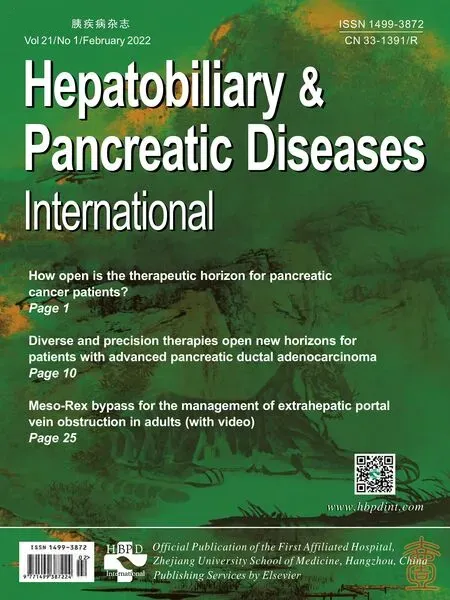 Hepatobiliary & Pancreatic Diseases International2022年1期
Hepatobiliary & Pancreatic Diseases International2022年1期
- Hepatobiliary & Pancreatic Diseases International的其它文章
- Targeting pancreatic ductal adenocarcinoma: New therapeutic options for the ongoing battle
- How open is the therapeutic horizon for pancreatic cancer patients?
- Terlipressin versus placebo in living donor liver transplantation
- Meso-Rex bypass for the management of extrahepatic portal vein obstruction in adults (with video)
- The effect of SphK1/S1P signaling pathway on hepatic sinus microcirculation in rats with hepatic ischemia-reperfusion injury
- Liver involvement in the course of thymoma-associated multiorgan autoimmunity: The first histological description
